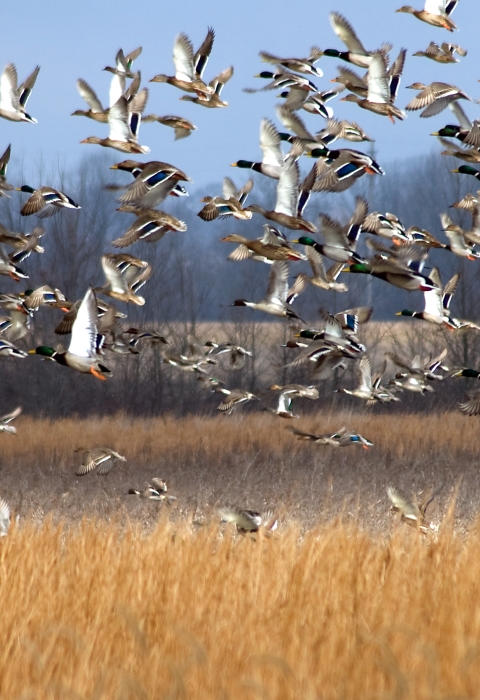Seasons of Wildlife
Winter
Ducks and geese, as well as bald eagles, are easy to spot around open water. Deer and other mammals who live here year round can also be found.
Spring
Migratory waterfowl and other birds, especially native sparrows, are here in large numbers. Frogs and toads emerge and are especially easy to hear in the evenings.
Summer
Fawns are often seen with their mothers, especially around dawn and dusk. Great egrets, great blue herons and many types of shorebirds are found in pools where water levels are drawn down in summer.
Fall
Tens of thousands of red-winged blackbirds, as well as tree and other swallows, roost in the marsh during the evenings. Large gatherings of northern pintails and other waterfowl are easily seen throughout the refuge during fall migration.
Featured Species
During the spring and fall you can see large gatherings of northern pintails and mallards using the refuge as a place to rest and feed during their migration. Pintails and mallards are dabbling ducks who primarily feed by using their bill to filter out grains, seeds, weeds, aquatic insects and crustaceans from the water. The male is easily distinguished by it beautiful color pattern and long tail, from which it gets its name.
Other duck species that use the refuge during the migration period include gadwalls, and teals, which usually can be seen from the entrance road. By using the viewing scopes located at the overlooks on the road to Swan Lake and on the nature trail, visitors can see other water birds like American white pelicans, Canada and greater white-fronted geese and trumpeter swans. The auto tour leads to Silver Lake, where snow geese and various diving duck species such as common mergansers, buffleheads, ring-necked ducks and lesser scaup feed and rest. Later in the spring and summer, great blue herons and great egrets are readily seen from this road.
During the late spring and late summer, shorebirds such as greater yellowlegs stop over at Swan Lake to take advantage of mudflat habitat. The greater yellowlegs, along with other shorebird species, will pick over these mudflats feeding on small aquatic and terrestrial invertebrates. To accommodate these birds, refuge staff draw down the water level in moist soil units to expose the mudflats during the shorebird migration periods.
Bald eagles can be seen year round at Swan Lake National Wildlife Refuge. The bald eagle, along with other raptor species such as the red-tailed and red-shouldered hawk, nest and raise their young on the refuge during the early spring and summer months. The largest concentration of bald eagles using the refuge can be observed during the late fall and winter as many of them follow the waterfowl migration to the refuge.
Besides the bald eagle, the refuge also provides habitat for a number of other migratory birds. We see many neo-tropical migrants, including eastern phoebes, Baltimore orioles, and summer tanagers. Several species of native sparrows are present during migration, including swamp sparrows in wetland shrubs and fox and white-throated sparrows in drier, brushy habitat. Both grasshopper and field sparrows nest on the refuge. Smith’s and Lapland longspurs are seen in fall and spring. In the fall, we see tens of thousands of red-winged blackbirds, as well as tree and other swallows, as they come into the marsh to roost in the evenings.
White-tailed deer are a common sight at the refuge and are best viewed in the evening time. During mid-summer, keep an eye out for fawns grazing and frolicking with their mothers in the refuge fields. Also keep an eye out for some of our other commonly seen resident wildlife species, such as fox squirrels, raccoons, coyotes, beaver, muskrats, opossums and cottontail rabbits. River otters live here, but are not often seen. Otters were reintroduced onto the refuge in 1982 by the Missouri Department of Conservation, and the success of the experiment led to a state-wide reintroduction program. Frog and toad surveys in past years have detected four species: western chorus frog, southern leopard frog, gray tree frog and northern spring peeper.
